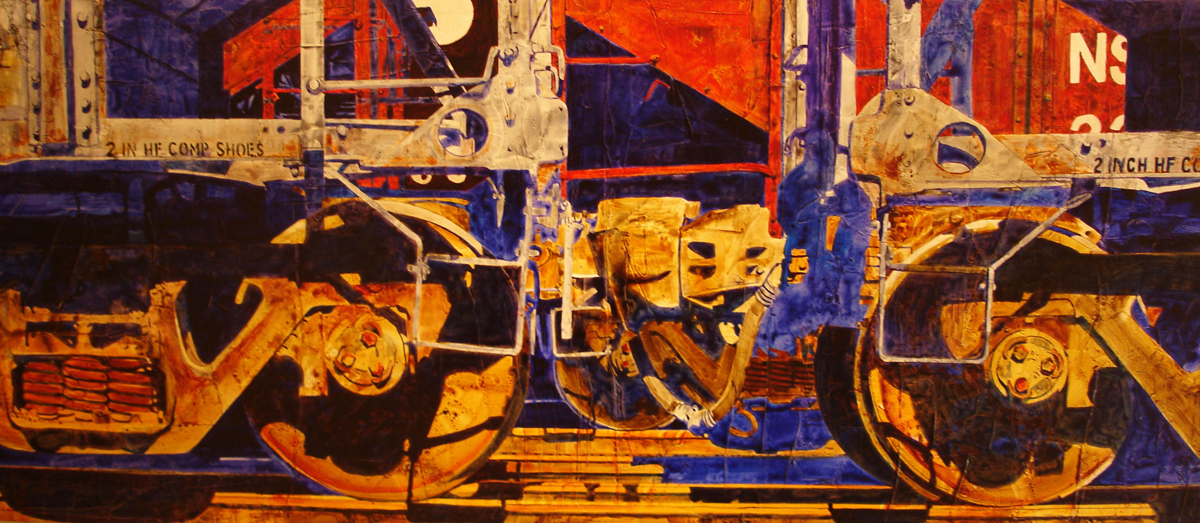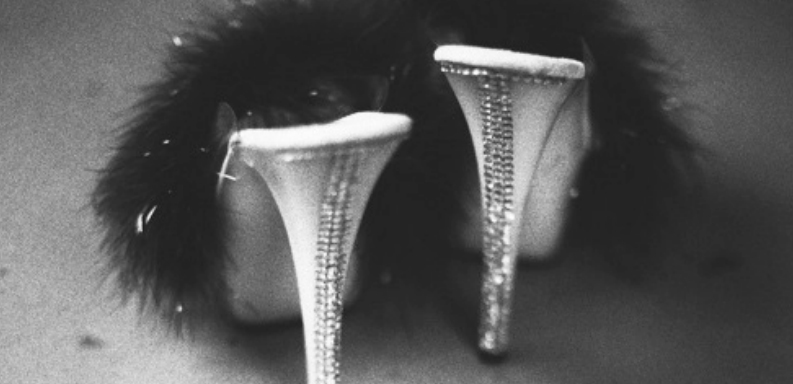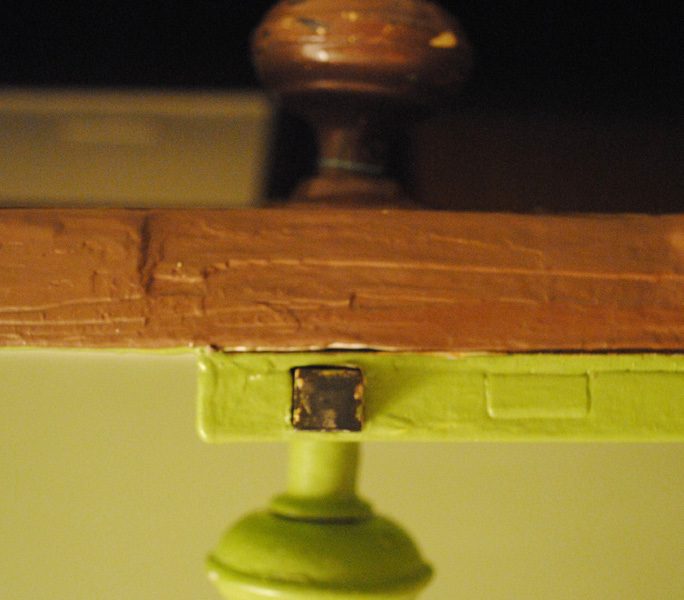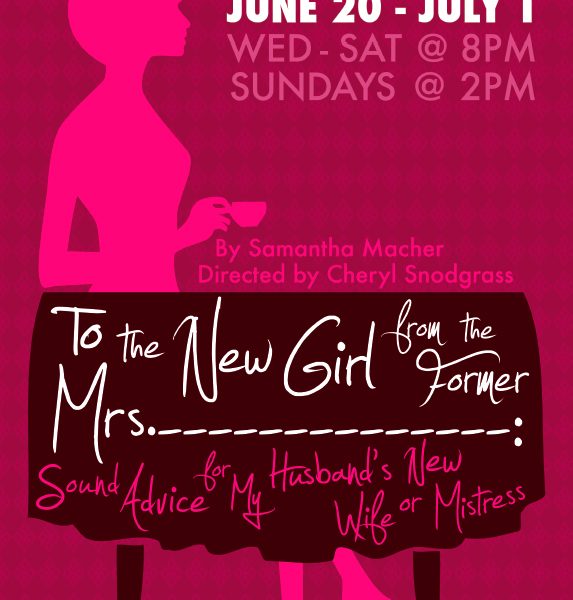This article was originally published in the third issue of VIA Noke Magazine, printed in Roanoke, Virginia in October 2012.
From her beginnings with watercolor, to her found object collages, we were eager to discover the path, award winning local artist, Nancy Stark followed what led her to the style of art she creates today.
CHELSEA: Have you always been interested in art?
NANCY: I have been interested in art all my life but the only formal art education I had was an after-school art club in New York State. I remember going to after-school art club and I still have one of the little paintings I did way back then. I didn’t listen to my mother who said, “Go to art school, go to art school, go to art school.” I didn’t go, so I have no formal art education.
In 1983, after I had my third child, I took a watercolor class at Blue Ridge Community College with Kay Flory. She was fabulous! Kay was supportive, encouraging, and I was hooked. I started out in transparent watercolors. I took Kay’s watercolor classes 1, 2, and 3, and then I began to look for other places where I could take classes. Except for that I have done a lot of workshops where you go and study for four or five days with an individual instructor. So I’ve spent a lot of time with other artists, and I’ve spent a lot of time in the studio just playing, experimenting, and seeing what I like to do.

EMILY: Do you look back on where you started and see anything that you’ve carried throughout? Or is it completely different now?
NANCY: What I see is that I started out on this path, like how Kay got me started on watercolor, and then different things impacted or knocked me off that path. I used to belong to the Shenandoah Watercolor Society and I was painting in transparent watercolor; I took some paintings to a critique where Charles Goolsby, the department chair of art at Emory and Henry College, was the guest critiquer. I put up this huge, full sheet watercolor painting with three rocking chairs, shadows, bushes, the front of the house, pillars, everything. He looked at it and said, “What do you like about this painting?” I pointed to the bottom half of the rocker and the shapes from the cast shadow. He looked at me and said, “Then why is all of this other stuff in the painting?” So I give Charles credit for my use of cropping in my work.
Somewhere along the way I was out with my husband, who is a train enthusiast, and we stopped to look at some trains one day. It was a bright sunny day and around the backside of the train there was this step with lots of round holes in it, and the shadows cast by it caught my attention. It was just shapes, so I got to thinking, “Why aren’t you painting things more like that?” I enjoy putting jigsaw puzzles together; I love to combine shapes and see how they fit and make up the whole. So I started on a different direction subject-wise.
I took a watercolor workshop with Carolyn Gawarecki, who is a Northern Virginia artist, and she said, “Shadows are not gray.” So, since that class, my shadows have become purple. And purple is a color that I use a lot in my paintings. I paint the whole painting first, and then I mix up a big juicy puddle of a dioxazine purple and French ultramarine blue, sometimes there are a few other colors in it. I weave that color throughout the painting, which helps to unify it because it’s always the darkest dark.
One night during Art By Night, Geri Stevenson and I left Signature 9 and we went around to other galleries, back when Richard Kurshan still had Studios on the Square, and the guest artist there was Joni Pienkowski. She was painting on doors and didn’t gesso them. She uses the grain of the door in her paintings so I thought to myself, “That’s a neat surface.” Before that I had been painting on watercolor paper but I decided I would gesso them first, which gives me texture to work with.
In a way I was on this path and Charles kind of bumped me off and got me to paint cropped images, then Carolyn’s comment about the shadows and Joni painting on doors, and I’ve taken a little bit of all of that along the way. And that is true of any artist; when you see the artwork of other people there is something in it that appeals to you and it sometimes, somehow comes out in you, incorporating things from different art that you like. So it’s a continuous path, but maybe not one I would have gotten to without outside influences.
CHELSEA: Before you start a piece, do you go out and roam and look at the trains as your subject matter and take pictures?
NANCY: Yes, I work from photographs. I generally go up and access the tracks where they’re restoring the Virginian Station on Williamson Road and they’re pretty good about letting you walk if they see you’ve got a camera; they know that you’re ok and not going to sabotage anything, I guess. So I try to get different shots and try to use the camera to crop what I think will be a good image. Many times I don’t even use the full image.
EMILY: So when did you start integrating the found objects?
NANCY: I can think back to the first one that I did. It has been three or four years that I’ve been integrating found objects. I am by nature a pack rat; I very rarely throw anything out.
Old things intrigue me, whether it’s rusty pieces of metal, or correspondence or photographs from years ago. My father-in-law passed away three years ago and I inherited his tool chest that had little drawers in it; inside of it were nuts and bolts and different things. And he was probably how you can trace back why I’m painting trains. So I’ve sort of come full circle. My father-in-law liked trains, I married his son, I’m painting trains, and now I have his stuff. So I started putting those things on the paintings themselves. Also, while I was putting these items on I was trying to keep in mind what kind of shadow they would actually cast when they’re lit. Because that’s another connection for me, I started painting the trains because of the cast shadows, and now I’m incorporating things that cast a shadow. So some of the shadows on my paintings are actually painted on with my purple mixture and some of them are just a shadow caused when these found objects are illuminated in a certain way.
I also inherited a lot of my grandfather’s written memorabilia. He was a contractor and I have a lot of his books, so I have a lot of his handwriting and I began incorporating that. I got an old autograph book from a great aunt that was falling apart; either you can keep it or you can do something with it, so I started incorporating the paper memorabilia. And it intrigues me a little bit as things that survive over time. Rust survives when it changes, and the paper and the photographs; it’s sort of what’s left behind when people that you knew are no longer here.

CHELSEA: Do you work with any other medium than watercolor?
NANCY: I either work in watercolor or fluid acrylics, which are about the same consistency as heavy cream, but I’m not that interested in oil at the moment. I’ve done collage, and that goes back to incorporating things in the artwork. Right now I’m working on some commissions, and once they’re done I’m anxious to do a lot of large-scale floral painting. But they’re not just going to be floral; I’m interested in trying to incorporate a lot of shapes. I’ve done large-scale floral paintings with watercolor on plain paper but I’m going to try to do some on the wooden panels with gesso background. I’m also working on the boxes as another surface to paint on. All of my commissions are trains. And it’s interesting because when some people come through the booth at the sidewalk sale they comment, “Oh, you’ve got to love trains, or you’ve got to work for Norfolk Southern to be interested in them,” but I’ve sold them to people who have absolutely no connection to trains. And I think they see them more for the design and composition. I paint because it is the best therapy. A lot of times I have to make myself get in the studio, but once I’m there, there’s just something about it. But I do still like painting trains, and I will probably always paint trains.
“I paint because it is the best therapy. A lot of times I have to make myself get in the studio, but once I’m there, there’s just something about it.”
CHELSEA: I love texture; I see these works not as trains but more as the shadows, shapes, and an overall visual texture.
NANCY: My number one things are shape, color, texture, and pattern.
CHELSEA: Do you like using bold colors?
NANCY: When I first started painting the trains on the watercolor paper they were very representational, the steel grays and the rusty reds, but they have evolved into bright colors. I do enjoy bright colors.
CHELSEA: Do you have any specific artists that are your favorites or might influence your style?
NANCY: There are a lot that are my favorites. I like Matisse, I love the cutouts, the shapes, the bright colors. There are several fabulous contemporary artists that I love; one in particular that I admire is Elaine Daily Birnbaum. She does fabulous abstract paintings.

“Complementary Colors II,” Nancy Stark 
“On the Side Track,” Nancy Stark 
“Where Does It End,” Nancy Stark 
“Red Letter Day,” Nancy Stark 
“Brakewheel Shadows,” Nancy Stark
You can see Nancy’s work at Signature 9 Gallery or online at nancystarkart.com.




